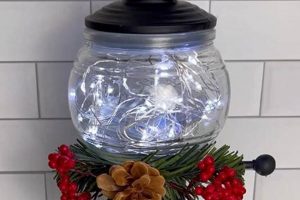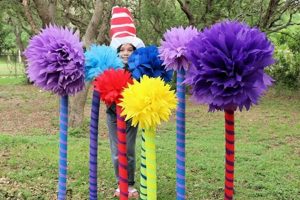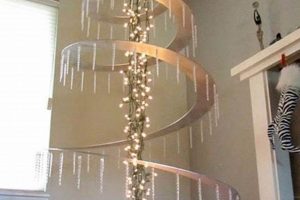A handcrafted base designed to elevate and support a holiday centerpiece, often constructed from wood or repurposed materials, can enhance the aesthetic presentation of a Christmas tree. This structure, typically square or rectangular, conceals the traditional tree stand and provides a more visually appealing foundation. Examples include boxes built from reclaimed pallets, painted plywood enclosures, or fabric-covered frames designed to complement holiday dcor.
The advantages of creating a custom tree base include the opportunity for personalization, cost savings compared to purchasing commercial alternatives, and the ability to integrate it seamlessly into a specific interior design scheme. Historically, simple tree stands were utilitarian. Modern interpretations prioritize visual appeal, transforming the base into a decorative element that contributes to the overall festive ambiance. This also provides a surface to decorate or further personalize the Christmas tree experience.
The following discussion will explore various construction methods, material selections, and decorative techniques for creating unique and aesthetically pleasing foundations for Christmas trees. Considerations will include structural integrity, safety precautions, and design options suitable for diverse skill levels and aesthetic preferences. This will provide a clear guide for those seeking to build their own custom base.
Essential Considerations for a Handcrafted Christmas Tree Base
Creating a structurally sound and visually appealing foundation for a Christmas tree requires careful planning and execution. The following considerations will enhance the quality and longevity of a self-made base.
Tip 1: Material Selection: Opt for wood species known for their strength and stability, such as pine, fir, or plywood. Ensure materials are free from excessive knots or warping, which can compromise structural integrity. Untreated wood can be used, provided a sealant or paint is applied for moisture protection.
Tip 2: Precise Measurements: Accurate dimensions are crucial. Measure the existing tree stand’s footprint and add at least two inches of clearance on all sides to accommodate it comfortably. Consider the desired height of the base, ensuring it complements the overall tree height and room proportions.
Tip 3: Robust Construction: Employ strong joinery techniques, such as screws, nails, or wood glue, to assemble the base. Reinforce corners with brackets or additional wood supports to enhance stability and prevent wobbling. Mitered corners provide a cleaner, more professional aesthetic.
Tip 4: Adequate Weight Distribution: For larger trees, consider adding a weighted base to prevent tipping. Concrete blocks or sandbags placed within the structure can provide additional stability. Ensure the weight is evenly distributed to avoid stress points.
Tip 5: Consider Ventilation: If using a live tree, ensure adequate ventilation within the base to prevent moisture buildup and mold growth. Drill ventilation holes or leave small gaps in the construction to promote airflow.
Tip 6: Secure Tree Stand Attachment: Implement a system to securely attach the tree stand to the base. This can be achieved through recessed supports, clamps, or strategically placed screws. A secure attachment prevents shifting and potential tipping hazards.
Tip 7: Finishing and Aesthetics: Apply a protective finish, such as paint, stain, or varnish, to enhance the base’s appearance and protect it from moisture damage. Consider the overall dcor of the room and choose a finish that complements the existing aesthetic. Adding decorative elements, such as trim, molding, or fabric, can further personalize the design.
Adherence to these principles will result in a safe, durable, and visually pleasing foundation that enhances the holiday experience. A well-constructed base provides stability, hides the unsightly tree stand, and becomes an integral part of the festive display.
The following sections will delve into specific design ideas and construction techniques to further guide the creation process.
1. Material Durability
Material durability is a paramount consideration when constructing a handcrafted Christmas tree base. The longevity, stability, and safety of the structure are directly correlated with the inherent properties of the chosen building materials. Selecting durable components ensures the base can withstand repeated use, potential moisture exposure, and the weight of the tree itself.
- Resistance to Decay
Wood is a common material for these bases; however, its susceptibility to rot and insect infestation necessitates careful selection. Using naturally decay-resistant woods like cedar or redwood, or pressure-treating softer woods like pine, significantly extends the lifespan of the base. Neglecting this aspect can lead to structural weakening and eventual failure, particularly in humid environments.
- Load-Bearing Capacity
The selected material must be capable of supporting the weight of the Christmas tree, water (if using a live tree), and any decorations. Plywood, for example, offers a good balance of strength and affordability. The thickness and grade of the plywood should be chosen based on the anticipated load. Insufficient load-bearing capacity can result in bending, cracking, or complete collapse of the base.
- Moisture Resistance
Exposure to moisture from watering live trees or accidental spills can damage the base over time. Applying a waterproof sealant or finish is crucial, especially for wood. Materials like PVC or composite decking offer inherent moisture resistance but may present different aesthetic considerations. Failure to address moisture exposure can lead to warping, swelling, and ultimately, structural degradation.
- Impact Resistance
The base is susceptible to accidental bumps and impacts during the holiday season. Materials with good impact resistance, such as solid wood or reinforced plywood, are less likely to sustain damage from such events. This prevents unsightly dents, cracks, or structural weaknesses. Choosing brittle materials without adequate reinforcement can result in cosmetic or structural damage from relatively minor impacts.
The strategic selection of durable materials is not merely an aesthetic choice; it’s an investment in the long-term functionality and safety of a handcrafted Christmas tree base. By prioritizing resistance to decay, sufficient load-bearing capacity, moisture resistance, and impact resistance, builders can create a robust and reliable foundation for their holiday centerpiece, ensuring years of festive enjoyment.
2. Dimensional Accuracy
Dimensional accuracy is paramount in the construction of a handcrafted Christmas tree base. Precise measurements and adherence to those dimensions are critical for ensuring both the structural integrity of the base and the overall aesthetic appeal of the Christmas tree display. Deviations from accurate measurements can lead to instability, visual imbalances, and potential safety hazards.
- Internal Accommodation of Tree Stand
The internal dimensions of the base must accurately accommodate the existing Christmas tree stand. If the internal space is too small, the stand will not fit properly, leading to instability. Conversely, if the space is too large, the stand may shift and wobble, creating a tipping hazard. Precise measurements of the stand’s footprint, including the base and any protruding components, are essential for ensuring a secure and stable fit. An example of poor execution would be building a base based on approximate measures, resulting in a Christmas tree base that cannot be effectively used and secured.
- External Proportions and Visual Balance
The external dimensions of the base must be proportionate to the size of the Christmas tree and the surrounding environment. A base that is too small will appear visually unbalanced and may not provide adequate support for the tree. A base that is too large will overwhelm the tree and detract from its aesthetic appeal. Calculating the appropriate external dimensions based on the tree’s height and width, as well as the room’s proportions, is critical for achieving visual harmony. If the visual balance is poor, the visual appeal of the Christmas tree and, by extension, the decoration, is drastically reduced.
- Material Cut Accuracy
Accurate cutting of materials is essential for achieving precise dimensions. Whether using wood, metal, or other materials, precise cuts ensure that the components fit together seamlessly and create a structurally sound base. Inaccurate cuts can result in gaps, misalignments, and weakened joints, compromising the overall integrity of the structure. Employing accurate measuring tools, such as a precision ruler and a reliable saw, is crucial for ensuring accurate cuts. Failure to correctly cut the materials will result in a sub-par final product that is unstable and lacks aesthetic appeal.
- Joint Precision and Assembly
The precision of the joints connecting the various components of the base directly impacts its overall stability and appearance. Accurate measurements and precise cuts are essential for creating tight, secure joints that can withstand the weight of the tree. Sloppy joints will weaken the structure and create unsightly gaps. Employing appropriate joinery techniques, such as mitered corners, dovetail joints, or secure screw attachments, enhances the precision and strength of the assembly. Careless joint construction leads to a structurally unsound and visually unappealing piece, defeating the purpose of creating a decorative base.
In summary, dimensional accuracy is not merely a matter of aesthetics; it is a fundamental requirement for creating a safe, stable, and visually appealing Christmas tree base. By prioritizing precise measurements, accurate cuts, and careful assembly, builders can ensure that their handcrafted base provides a solid foundation for their holiday centerpiece, enhancing the overall festive atmosphere.
3. Structural Stability
Structural stability represents a critical component in the design and construction of a do-it-yourself Christmas tree box stand. The connection is one of direct cause and effect: inadequate structural integrity results in a base prone to collapse, tipping, or other forms of failure under the weight of a Christmas tree. The significance of structural stability cannot be overstated, as it directly impacts the safety of the surrounding environment and the longevity of the decorative piece. A real-life example would involve a base constructed from thin, unsupported plywood; such a structure would likely buckle or break under the load of a large tree, posing a hazard to people and potentially damaging nearby objects. Understanding this connection is of practical significance because it dictates material selection, construction techniques, and overall design considerations. The choice of wood, joinery methods, and internal support systems all contribute to the base’s ability to withstand the forces exerted upon it.
Further analysis reveals specific applications of structural principles in the construction process. For example, incorporating corner bracing or internal ribs significantly enhances the base’s resistance to bending and shearing forces. The size and spacing of fasteners (screws, nails, or bolts) directly influence the strength of the joints connecting different panels of the box. Furthermore, the dimensions of the base itself play a role; a wider base inherently provides greater stability against tipping. Consider the practical application of reinforcing corners with metal brackets or adding a weighted bottom to lower the center of gravity. These actions directly address potential weak points and improve the overall stability of the structure. Additionally, when a family has small kids, a base with better structural stability has a great impact in safety aspects.
In summary, structural stability is an indispensable element of any DIY Christmas tree box stand. Failure to adequately address this aspect can lead to hazardous situations and a premature degradation of the base. Challenges in achieving sufficient stability often arise from cost constraints, limited material availability, or a lack of construction expertise. However, careful planning, informed material selection, and adherence to basic structural principles can overcome these challenges. The concept links to the broader theme of responsible craftsmanship, emphasizing the importance of creating functional and safe decorative objects. Prioritizing structural stability provides a Christmas tree base that is not only aesthetically pleasing but also reliable and secure for seasons to come.
4. Design Integration
Design integration, within the context of a handcrafted Christmas tree base, refers to the seamless incorporation of the structure into the existing aesthetic of a space. This consideration extends beyond mere functionality, focusing on harmonizing the base with the surrounding dcor, architectural style, and overall atmosphere of the room. A well-integrated design enhances the visual appeal of the tree and elevates the festive ambiance.
- Harmonization with Existing Dcor
The selection of materials, colors, and finishes should align with the established design scheme. For instance, a modern minimalist space might benefit from a base constructed from sleek, unadorned wood with a natural finish, while a traditional setting could accommodate a more ornate design with intricate carvings and a rich stain. Ignoring this aspect can result in a discordant element that detracts from the overall aesthetic. A clash in styles can diminish the perceived value and appeal of both the tree and the surrounding dcor.
- Consideration of Room Proportions
The size and shape of the base must be proportional to the dimensions of the room and the size of the Christmas tree. An excessively large base in a small room can appear overwhelming, while a diminutive base under a towering tree can seem inadequate. Careful consideration of spatial relationships ensures a balanced and visually pleasing arrangement. For example, a compact apartment may necessitate a smaller, more streamlined base design to avoid dominating the limited space.
- Material Consistency and Texture
The materials used in the construction of the base should complement the existing materials and textures in the room. A base crafted from rough-hewn wood might be suitable for a rustic setting, while a polished metal base could be a better fit for a contemporary space. The tactile quality of the materials also contributes to the overall aesthetic impression. Inconsistencies in material choice can create a sense of disjointedness and undermine the cohesiveness of the design.
- Incorporation of Thematic Elements
The design of the base can be enhanced by incorporating thematic elements that reflect the overall Christmas theme or personal preferences. This can be achieved through the addition of decorative details, such as painted motifs, stenciled patterns, or applied embellishments. A nautical-themed room, for example, could incorporate rope details or a painted anchor design. The integration of thematic elements adds a personal touch and strengthens the connection between the base and the broader festive dcor.
Effective design integration transforms the Christmas tree base from a purely functional object into an integral component of the holiday dcor. By carefully considering the surrounding environment, material choices, and thematic elements, creators can craft a base that seamlessly blends into the space, enhancing the visual appeal of the tree and contributing to a cohesive and festive atmosphere. A harmonious integration elevates the overall aesthetic experience and underscores the attention to detail that characterizes a well-designed holiday display.
5. Safety Features
Safety features are an indispensable consideration in the design and construction of a do-it-yourself Christmas tree box stand. Given the potential hazards associated with large, illuminated trees in domestic environments, incorporating safety measures is paramount to prevent accidents and ensure a secure holiday season.
- Tip-Over Prevention
A primary safety concern is the risk of the tree tipping over, particularly if it is large or heavily decorated. A wide, stable base is crucial to counteracting this risk. This can be achieved through a broad footprint, weighted materials within the base, or outrigger supports. Example: A base constructed from a lightweight material like thin plywood is inherently unstable. Adding concrete blocks inside the base or using a wider foundation significantly lowers the center of gravity and reduces the likelihood of a tip-over. The implications of inadequate tip-over prevention range from property damage to serious injury.
- Electrical Safety
Christmas trees are often adorned with numerous electrical lights, creating a potential fire hazard. The base should be designed to minimize the risk of electrical shock or fire. This includes providing adequate ventilation to prevent overheating, incorporating strain relief mechanisms for power cords, and ensuring that any electrical components are properly insulated and grounded. Example: A power cord pinched between the tree stand and the base can overheat and spark. Providing a designated channel for the cord and using a surge protector mitigates this risk. Failure to address electrical safety can result in fire, electrical shock, or damage to electrical appliances.
- Material Flammability
The materials used in the construction of the base should be selected with flammability in mind. Highly flammable materials, such as untreated wood or certain fabrics, should be avoided or treated with fire retardant coatings. This reduces the risk of the base contributing to a fire in the event of an electrical malfunction or other ignition source. Example: Using untreated pine for the base presents a greater fire risk than using fire-retardant-treated plywood. The consequences of using flammable materials can be catastrophic, especially if the tree is positioned near flammable drapes or furniture.
- Edge and Corner Protection
Sharp edges and corners on the base can pose a tripping hazard or cause injury, especially to children. Rounding off edges and corners or applying protective edging can minimize this risk. Example: Leaving sharp, exposed edges on the base creates a potential hazard for anyone walking nearby. Applying a rubber or plastic edging provides a soft, protective barrier. The ramifications of neglecting edge and corner protection can range from minor cuts and bruises to more serious falls and injuries.
These safety features are not merely optional additions; they are fundamental aspects of a responsible do-it-yourself Christmas tree box stand design. By carefully considering and incorporating these measures, builders can create a festive and secure environment for their holiday celebrations, prioritizing the well-being of their families and guests. Prioritizing safety features are as important as the appearance of a custom build tree stand base.
Frequently Asked Questions
This section addresses common inquiries and clarifies misconceptions regarding the construction and implementation of handcrafted Christmas tree box stands.
Question 1: What type of wood is best suited for constructing a Christmas tree box stand?
Durable softwood varieties, such as pine or fir, offer a balance of affordability and structural integrity. Plywood, particularly exterior-grade, provides stability and resistance to warping. Hardwoods like oak or maple offer superior strength but may be more expensive and challenging to work with. The appropriate choice depends on the desired aesthetic and structural requirements.
Question 2: How can the risk of the tree tipping over be minimized when using a box stand?
A wide base footprint is crucial for stability. Internal weighting, achieved by adding sandbags or concrete blocks, lowers the center of gravity. Securing the tree stand to the box stand using brackets or screws prevents shifting and potential toppling. The height of the box stand should be proportionate to the tree’s height to maintain balance.
Question 3: What fire safety precautions should be observed when building a Christmas tree box stand?
Untreated wood is flammable. Applying a fire-retardant coating or using fire-resistant materials minimizes the risk of ignition. Ensuring adequate ventilation within the box stand prevents heat buildup from electrical lights. Regularly inspecting electrical cords for damage and using surge protectors are also essential safety measures.
Question 4: How should a box stand be sized to accommodate a standard Christmas tree stand?
Accurate measurements of the existing tree stand’s base are essential. The internal dimensions of the box stand should exceed the tree stand’s footprint by at least two inches on all sides to allow for easy placement and adjustment. Additional clearance may be necessary for tree stands with protruding components.
Question 5: What are the optimal methods for joining the panels of a box stand?
Screws and wood glue provide a strong and durable connection. Nails may be used for less critical joints, but screws offer greater holding power. Mitered corners create a cleaner, more professional aesthetic than butt joints. Corner brackets can provide additional reinforcement for enhanced stability.
Question 6: How can a Christmas tree box stand be integrated with existing home decor?
The choice of paint, stain, or fabric covering should complement the room’s color scheme and style. Adding decorative trim, molding, or stenciled designs can enhance the visual appeal. Consider the overall theme of the Christmas decorations and incorporate elements that reflect that theme in the design of the box stand.
Construction of a structurally sound and aesthetically pleasing tree base is a practical matter. This is achieved through a combination of careful planning, responsible material selection, and diligence during the assembly process.
The following section will explore detailed step-by-step instructions for building a basic Christmas tree box stand.
DIY Christmas Tree Box Stand
This exploration of the diy christmas tree box stand concept has underscored the importance of structural integrity, material selection, and aesthetic integration. Successful construction demands a clear understanding of load-bearing principles, fire safety, and dimensional accuracy. The presented information provides a comprehensive guide for those seeking to elevate their holiday decor through a custom-built base.
The construction of a diy christmas tree box stand represents more than a mere decorative endeavor; it embodies a commitment to craftsmanship and a personalized approach to seasonal traditions. The information shared encourages informed decision-making, ensuring that each project prioritizes both visual appeal and long-term safety. Those that embrace this undertaking will achieve a unique foundation for their holiday centerpiece.







